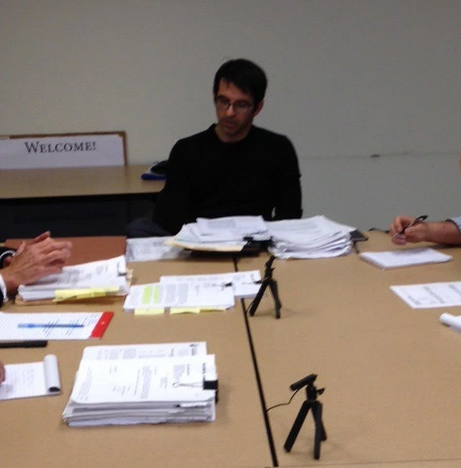Zoning decision on Soma building sends a message that developers can’t just turn industrial space into offices

By Zelda Bronstein
SEPTEMBER 8, 2015 — San Francisco’s zoning administrator has finally ruled that a Soma landlord illegally converted an entire industrial building to office use – a rare decision that gives some hope that the rampant loss of production, distribution, and repair could be slowed.
Scott Sanchez ruled on Aug. 28 that the two lower floors of 660 Third Street are zoned for PDR, and set fines of $250 a day until the existing office and retail tenants are removed.
At a May 14 Zoning Administrator hearing, attorney James Reuben, a principal at Reuben, Junius & Rose, argued that since the Planning Commission had allowed other PDR properties, including one across the street at 665 Third, to be converted to office space, the total conversion of 660 Third should be fine.
But Sanchez was not persuaded.
In the mid-Nineties, the family, which runs one of the world’s biggest industrial liquidation companies, Rabin Worldwide, illegally converted 660 Third from PDR into offices. For almost a decade, it housed the headquarters of Wired Magazine.
In May 2013 the Rabins asked the city to retroactively authorize the illegal conversion. After all, the Planning Commission had recently okayed the same request for other SoMa properties.
But at 660 Third, there were problems.
For starters, at the Planning Commission’s hearing in May 2014, community activists—land use attorney Sue Hestor, CCHO Co-director Peter Cohen, MEDA Policy Manager Gabriel Medina, TODCO Director of Community Planning Alice Light, and SoMa Leadership Council President, the late Jim Meko—came out against the authorization.
Then 48 hills did an in-depth investigation and found significant irregularities in the owners’ application to the city.
The Rabins’ lawyer, David Silverman, also from Reuben, Junius & Rose, had claimed that the building lacked loading capacities and was therefore inappropriate for PDR. That was patently untrue; 660 Third has a loading dock and two interior freight elevators.
Silverman had also claimed that the building was empty, and that the owners couldn’t find PDR tenants. The first claim was untrue, the second highly dubious. As SFMade has brilliantly demonstrated, the city’s manufacturing sector is booming, but PDR businesses are leaving San Francisco because they can’t find space to rent. The major source of the shortage is the city’s failure to enforce its PDR zoning laws and its concomitant facilitation of illegal conversions of light industrial space to tech offices.
But Silverman’s misrepresentation of the truth—and the city’s failure to correct him—had a pivotal effect on the approval process.
Thanks to a loophole in the city’s zoning code, if a building in the SLI (Service/Light Industrial) zoning district has been designated an historic resource, it can be used for general offices. In February 2014 the Historic Preservation Commission granted 660 Third just such a designation, after Silverman had presented his fabrications—and, crucially, after city planner Rich Sucré, had let those fabrications go unchallenged. (Three months later, Sucré told the Planning Commission that the building was filled with office tenants.)
The Rabins must have thought that the historic resource designation had cleared the way for a full PDR-to-office conversion of the property. It worked for 665 Third; why not for 660 Third?
Instead, on September 11 the Planning Commission said that only the two upper floors could be converted to offices; the lower two floors had to be rented to PDR tenants.
The Rabins did not appeal the decision within the 30-day deadline. And they paid the city the substantial impact development fees approved by the commission. But they continued to rent the lower two floors to offices and, it appeared, a retail business.
On April 4, the Planning Department sent the building’s owners a Notice of Violation (NOV).
The Rabins appealed the NOV and requested a Zoning Administrator Hearing.
At the hearing, which I attended, Reuben contended that in authorizing only two floors of office use, the Planning Commission had abused its discretion. As I reported on May 21, in support of that contention, Reuben did not cite a single provision of the City’s Planning Code or a single approved permit for office conversion at 660 Third. Rather, he referenced the commission’s authorization of the illegal office conversion of the former PDR building at 665 Third.
On August 28, Sanchez issued his decision: 660 Third “is in violation of Planning Code Section 174.” Section 174 stipulates:
Every condition, stipulation, special restriction, and other limitation imposed by administrative actions pursuant to this Code, whether such actions are discretionary or ministerial, shall be complied with in the development and use of land and structures.
The specific “condition, stipulation, special restriction, and other limitation” at hand was the Planning Commission’s September 11, 2014 decision that the bottom two floors of 660 Third had to be used for PDR.
Sanchez noted that at the hearing, Reuben had
argued that the use of the subject property is a legal non-conforming office use and should be permitted to continue based on the following:
- A history of Building Permit approvals from the Department of Building Inspection (DBI) and the Planning Department for tenant interior and exterior improvements
- The establishment and operation of an office use specifically for auction sales; and
-
The subject property should be granted the same office use entitlements from the Planning Commission as other similar properties nearby.
The Zoning Administrator rejected all of these arguments.
“While evidence, including an extensive history of building permits and previous office use authorizations for similar buildings were submitted,” Sanchez wrote, “this decision focuses on the findings from the 2014 Conditional Use authorization [i.e., the Planning Commission’s action], a 1987 Variance decision, and other findings.”
Sanchez reported that on April 17, as part of his response to the Notice of Violation, Reuben had submitted copies of 66 building permits for interior and interior tenant improvements authorized by the Department of Building Inspection and/or Planning Department. “However,” Sanchez wrote, “this permit history did not contain permits with Planning Department authorization to change the use of the first and second floors of the building to an office use.”
The Zoning Administrator also reported that in a May 28 email, Reuben had argued that that 1996 Certificate of Appropriateness for the installation of new windows and handicap access improvements issued by the acting director of the Planning Department “served to acknowledge the use of the subject property as office.”
Sanchez commented: “the COA is not the mechanism that serves to authorize a change of use.” A footnote in his decision cites the COA itself: “this is not a permit to commerce any work or change occupancy. Permits from appropriate departments must be secured before work is stated or occupancy is changed.”
In 1987, the Planning Department authorized a building permit for off-street parking, granted specifically for various uses in 660 Third. But those uses included only 5,500 square feet of accessory office space on the fourth floor to serve an auction use located on that same floor.
Sanchez concluded:
While the Planning Department appreciates the good faith efforts of the property owners to seek office use entitlements, based on the above findings, it is my decision that use of the first and second floors of the subject property are not authorized for an office use.
The City has assessed the owners administrative penalties of $250 per day for each day the violation continues unabated, excluding the period of time the NOV has been pending before the Zoning Administrator. The NOV was issued on April 2; the hearing occurred on May 14.
Meanwhile, for a full year the Rabins have collected office and retail rents from their illegal tenants on the lower two floors of their property.
This decision ends a chapter in the saga of 660 Third, but it may not close the book: the Rabins have 15 days from August 28 to appeal the decision and assessed penalties to the Board of Appeals. As of Friday afternoon, September 2, they had not appealed.
For the moment, Sanchez’s decision upholding the Planning Department’s resolution stands as a small victory for San Francisco’s working class and a satisfying run-up to Labor Day.



